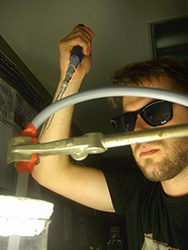In most diatom species, NPQ is proportional to the concentration of the xanthophyll pigment diatoxanthin, which is produced during the xanthophyll cycle. In saturating light conditions, the epoxidized xanthophyll diadinoxanthin is converted into its de-epoxidized form diatoxanthin, whereas the opposite reaction is observed in light-limiting conditions. Despite the central role of the xanthophyll cycle in light responses, the regulation of the rates of the de-epoxidase and epoxidase enzymes is not yet well understood. For example, most models still attribute a passive role to the epoxidation reaction despite the observations that its rate changes significantly with light conditions.
To model the xanthophyll cycle enzyme activities and to understand their regulation in different light conditions, we monitored diatoxanthin kinetics by making use of the proportionality between diatoxanthin and NPQ. This revealed that NPQ is established at saturating light conditions by a strong decrease in epoxidation activity and an increase in de-epoxidation activity. In addition, we showed that the light intensity, whereby the epoxidation kinetics are fastest, shifts together with the light saturation point when cells are acclimatized to higher or lower irradiances, arguing for an active role of the epoxidation enzyme in the fine-tuning of NPQ.
* This project is supported by the ERC starting Grant PhotoPHYTOMICS
